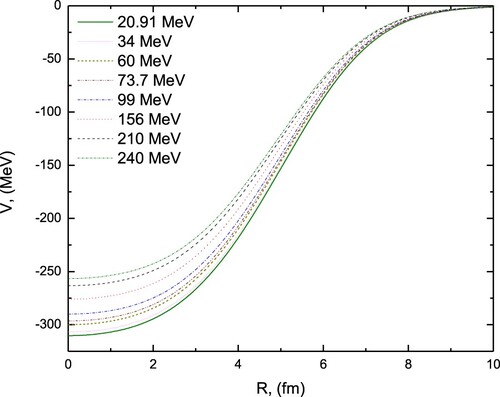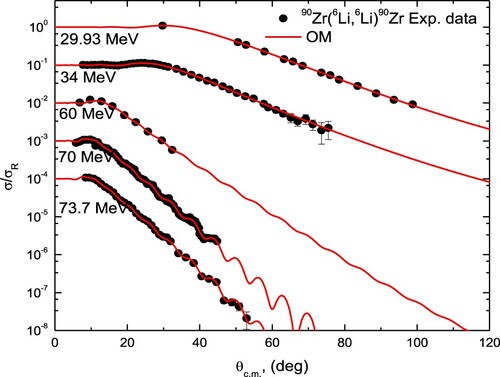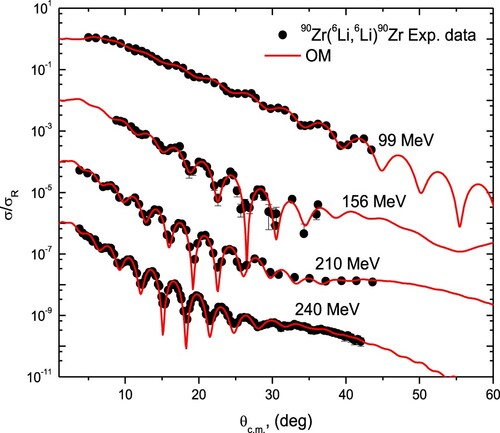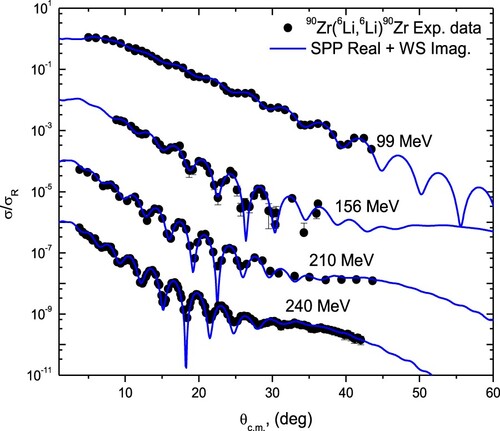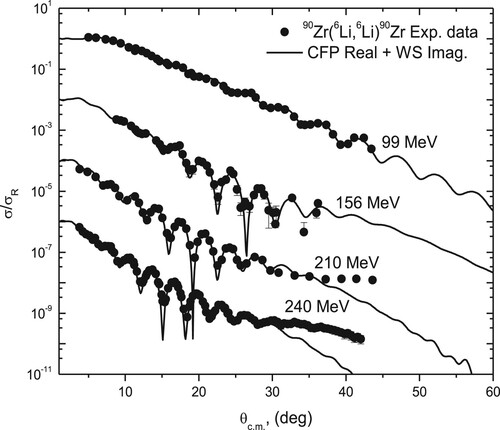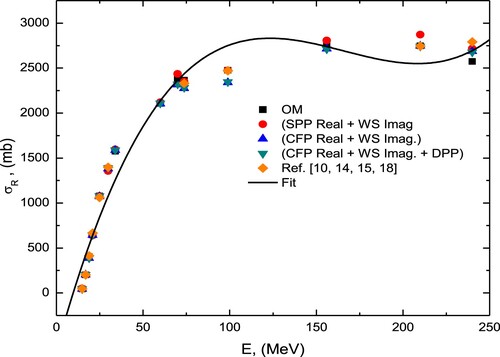 ?Mathematical formulae have been encoded as MathML and are displayed in this HTML version using MathJax in order to improve their display. Uncheck the box to turn MathJax off. This feature requires Javascript. Click on a formula to zoom.
?Mathematical formulae have been encoded as MathML and are displayed in this HTML version using MathJax in order to improve their display. Uncheck the box to turn MathJax off. This feature requires Javascript. Click on a formula to zoom.Abstract
The experimental angular distributions for 6Li elastically scattered from a 90Zr target in the energy range 14.89–240 MeV are theoretically reanalyzed using phenomenological and semi-microscopic potentials. The phenomenon of the break-up threshold anomaly (BTA) is well represented in the various used potentials. In analyzing nuclear systems induced by weakly bound projectiles such as 6Li, the well-known reduction in the strength of the real part of potential generated based on double folding (DF) and cluster folding (CF) models is also observed. The Sao Paulo potential (SPP) is used to perform double folding calculations. In order to fit the data fairly, a reduction of ∼ 42% and 45% in the strength of the microscopic real part of potential constructed using SPP and CFM, respectively, is found to be required. By including an additional dynamical polarization potential, the data are also reproduced without renormalizing the real cluster folding potential.
1. Introduction
Study of nuclear processes involving weakly bound projectiles is a hot topic of research as it could play a key role in understanding the mechanism of interactions induced by radioactive unstable beams. Weakly bound projectiles have pronounced cluster structure such as the α+d observed at threshold energy E = 1.47 MeV in 6Li, and α+t at E = 2.467 MeV in 7Li. This high clusterization probability causes strong coupling to the break-up channel, resulting in a significant reduction in the microscopic real potential strength. This observed reduction in real potential strength could be simulated by the inclusion of a dynamical polarization potential (DPP) [Citation1–3], which was taken in numerous studies as a real repulsive surface potential. The inclusion of such DPP has led to a successful reproducing for the experimental data for X + nucleus systems (X is a weakly bound projectile such as 6,7Li and 9,10Be) without renormalizing the potential [Citation4–8]. Another interesting feature for systems involving weakly projectiles is the absence of the usual threshold anomaly (TA) normally observed in systems involving tightly bound projectiles which exhibited a localized peak in the real part with a sharp decrease in the imaginary part with decreasing the projectile’s energy towards the Coulomb barrier energy (EC.B.). This absence is mainly due to the strong coupling to the break-up channel, which has a significant effect, and it is commonly known as the break-up threshold anomaly (BTA) [Citation9]. Therefore it is sometimes difficult to apply the dispersion relation to system of high break-up nature.
In our previous studies [Citation4–8], the mechanism of interaction for the weakly bound 6Li and 9,10Be projectiles scattered from different targets were investigated. The current study complements such aforementioned studies. In the current study, the 6Li+90Zr system at various energies ranging from near EC.B up to relatively high energies is subjected to further investigation. In connection with this goal, we summarize briefly the most important experimental and theoretical studies concerning this system.
Fortunately, extensive angular distribution (AD) measurements and theoretical studies for the 6Li+90Zr system [Citation10–24] are available to assist us in analyzing this system over a wide range of energies. In Ref. [Citation10], the 6Li+90Zr elastic scattering ADs in the energy range of 11–30 MeV were performed. The data was analyzed using optical model (OM) and double folding (DF) potentials. Continuum discretized coupled channel (CDCC) method was adopted and a good fit with the data was achieved. The performed analyses predict the break-up coupling effects. The DPPs extracted from the CDCC calculations for 6Li+90Zr were compared to those for 6Li +208Pb and 6Li +28Si systems, and similar energy dependence was obtained. In Ref. [Citation11], the elastic and inelastic 6Li+90Zr ADs at Elab = 34 MeV were measured, leading to the 2+ (2.18 MeV) and 3- (2.75 MeV) 90Zr excited states. Data was analyzed using OM and the distorted wave Born approximation (DWBA) method, and the deformation parameters for 2+ and 3- excited states were extracted. In Ref. [Citation12], elastic scattering and transfer (proton pick up) ADs for 89Y and 90Zr induced by 6Li projectiles at Elab = 60 MeV were measured. Data were analyzed using both OM and finite range DWBA. The extracted spectroscopic factor for the configuration 7Be→6Li + p were in a good agreement with theoretically reported values. In Ref. [Citation13], ADs for 6Li ions of energy 70 MeV is elastically and inelastically scattered from 90,92,94,96Zr were measured leading to the 2+ and 3- excited states for the different considered Zirconium isotopes. DF potentials were adopted in data analysis which leads to good description for the 2+ state but underestimated the cross-sections for the 3- state. In Ref. [Citation14–17], the measured ADs for 73.7, 99, 156, and 210 MeV 6Li ion beams, respectively, scattered from different targets, among them 90Zr were analyzed using OM Woods-Saxon (WS) potential, and the extracted potential parameters exhibited both discrete and continuous ambiguities. In Ref. [Citation15], in addition to the performed OM calculations for the 6Li+90Zr system, the single folding 6Li potential gave a good description of the data only after renormalization of the real potential by a factor of ∼ 0.5. In Ref. [Citation18], elastic and inelastic scattering of 240-MeV 6 Li particles from 58Ni and 90Zr were measured. Data was analyzed using the DF approach with the density-dependent M3Y NN interaction; the obtained renormalization factors (Nr) for the two considered targets were ∼ 0.87.
In Ref [Citation20], ADs for 6Li at energy of 40 MeV /nucleon elastically scattered from different targets were analyzed within the framework of the optical double folding model based upon the density-independent M3Y effective interaction. In Ref. [Citation21], a large body of experimental data for 6Li elastically scattered from 24Mg to 209Bi targets at energies below 250 MeV was analyzed systematically in order to obtain the 6Li global phenomenological OM potential. The extracted OM potential was found to be applicable to other targets outside of the considered mass range. In Ref. [Citation22], relativistic corrections to the reaction kinematic parameters were made for some nuclear systems, among them 6Li+90Zr elastic scattering ADs at energies between 20 and 100 MeV/nucleon. The main finding of the study is that the effects of such corrections are important when describing the ADs for heavy ion scattering at energies as low as around 40 MeV/nucleon. In Ref. [Citation23], the break-up coupling effects on the formation of the nuclear rainbow were investigated. To that end, data from the refractive elastic scattering of 6Li from various targets, including 90Zr at 35 MeV/nucleon, were reanalyzed using the (CDCC) method to account for the coupling effects that coming from the break-up of 6Li into α and d. The calculations were performed by switching on and then by switching off the break-up coupling for comparison. The main finding of this study was that the break-up coupling can boost the nuclear rainbow, although it also damps the elastic scattering cross-sections.
2. Data analysis methodology
2.1 Data analysis within the framework of OM
Optical model (OM) is a powerful tool for understanding and describing the interaction between two colliding nuclei by reducing the solution of Schrödinger equation from n-body problem – n, is the total number of nucleons existed in both projectile and target nuclei – into one body system of mass equal the reduced mass (μ) and is moving in a potential well created by all other nucleons. So, in order to investigate the mechanism of interaction for a specified nuclear system, it is preferable to start with OM analysis as a first step, and hence the analysis could be developed further by adopting more microscopic approaches which use different forms for the density distributions of the interacting nuclei and also the effective nucleon-nucleon interaction potential (VNN). For these reasons, the available ADs for 6Li elastically scattered from a 90Zr target in the energy range of 14.89–240 MeV [Citation10–18] are reanalyzed first from the phenomenological point of view using OM. The utilized central potential consists of both the Coulomb part of radius
and nuclear part. The nuclear part has a real volume part which describes the scattering, and imaginary volume term to simulate the absorption. Both of these have a Woods-Saxon (WS) shape. The parameters considered by A. Nadasen et al. [Citation17] are taken as starting parameters. In was found that the effect of spin orbit potential (VSO) on the 6Li-prjectile is small and it can be excluded. The utilized OM potential has the following shape:
(1)
(1)
The is the Coulomb potential between two charged spheres representing the projectile and target nuclei.
2.2. Data analysis using real Sao Paulo potential (SPP)
Due to the parameter ambiguities associated with OM calculations, and the fact that the phenomenological representations do not include a description of the internal structure of both the projectile and target nuclei, it is appreciable to derive the interaction potential from microscopic approaches such as double folding (DF). From this perspective, the real part of nuclear potential is constructed by the double folding procedures extracted from the Sao Paulo potential (SPP) NN interaction [Citation25–28].
(2)
(2) where
and
are the nuclear matter density distributions of 6Li and 90Zr nuclei, respectively, with
= −456 MeV. The new Sao Paulo potential (SPP2) has already been implemented with nuclear densities obtained from the Dirac-Hartree-Bogoliubov model [Citation28].
The following two equations link the real part of the local-equivalent interaction to the DF potential as
(3)
(3) and
(4)
(4) where v is the local relative velocity between the two nuclei and C is the speed of light. The effects of the Pauli non-locality can be numerically obtained by solving Equations (3) and (4) in an iterative process. The effects of the Pauli non-locality cause the SPP to be velocity dependent. Nuclear densities for 6Li and 90Zr, which were obtained from the Dirac-Hartree-Bogoliubov model [Citation29], are employed to calculate the nuclear potentials. The obtained SPP at Elab = 20.91, 34, 60, 73.7, 99, 156, 210 and 240 MeV as expressed in Equation (2) is shown in Figure .
2.3. Data analysis within the framework of CFOM
Due to the well-known α + d cluster nature of 6Li and its very low binding energy (6Li nucleus is bound by 1.47 MeV). It is appreciable to construct the 6Li+90Zr potential based on the 6Li cluster structure. This weakly bound nature is responsible for the various break-up effects in systems induced by 6Li-b projectiles. Consequently, it is necessary to examine the applicability of cluster folding (CF) model based on previous works [Citation30], where the 6Li cluster model was well established in reproducing the 6Li+90Zr elastic scattering ADs. In connection with this aim, the 6Li+90Zr data are reproduced utilizing the cluster folding optical model (CFOM) where, real part of the potential is defined based on the α + 90Zr and d + 90Zr potentials:
(5)
(5) where (
and
) is the real potential for α+90Zr and d+90Zr channels, which reasonably fit the data at suitable energies Ed ≈ 1/3ELi and Eα ≈ 2/3ELi [Citation31, Citation32],
is the intercluster wave function that describes the relative motion of α and d in the ground state of 6Li, and
is the relative coordinate between the centres of mass of d and α. The α-d bound state form factor represents a 2S state in a real WS potential as was taken in Ref. [Citation4]. The parameters needed to prepare the cluster folding potential (CFP) for 6Li + 90Zr are the optimal potentials for d + 90Zr and α + 90Zr at suitable energies. The highest energy under consideration is 240 MeV. Therefore, the required potentials are
at Elab = 1/3 × 240 = 80 MeV and
at Elab = 2/3 × 240 = 160 MeV. Based on the previous experimental studies for d + 90Zr and α + 90Zr systems, the most suitable available data, which could be implemented to generate the CFP for 6Li + 90Zr are: d + 90Zr at Elab = 56 MeV [Citation31] and α + 90Zr at Elab = 141.7 MeV [Citation32], these data reasonably agree with the second highest energy under consideration (210 MeV). On one side, the AD for d + 90Zr at Elab = 56 MeV is fitted using real DF potential in addition to an imaginary surface and spin orbit terms “see Equation (6)”. Two forms for the real DF potential “SPP and CDM3Y6” were tested and both of them give equally good fitting as shown in Figure .
(6)
(6) With NR is the renormalization factor for the real DF potential. The imaginary surface potential is characterized by three parameters, namely, potential depth (WD), radius parameters (rD) and diffuseness (aD). The spin orbit potential is also characterized by three parameters, namely, potential depth (VSO), radius parameters (rSO) and diffuseness (aSO).
On the other side, the AD for α + 90Zr at Elab = 141.7 MeV is fitted with a real DF potential of CDM3Y6 interaction [Citation33] in addition to an imaginary volume part of the conventional WS shape “ see Equation (7)”.
(7)
(7)
The ADs for d + 90Zr at Elab = 56 MeV and α + 90Zr at Elab = 141.7 MeV and theoretical calculations are in a good agreement as shown in Figures and , respectively using the potential parameters listed in Table . The potentials obtained from Table are used to generate the real CF potential expressed in Equation (5) as shown in Figure .
Figure 2. The d + 90Zr elastic scattering AD at Elab = 56 MeV and the theoretical fit using real (SPP and CDM3Y6) plus an imaginary WS term.
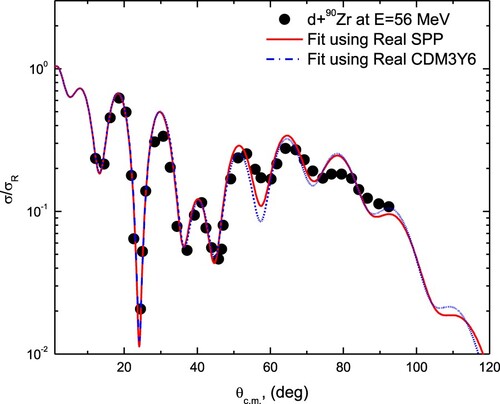
Figure 3. Comparison between α + 90Zr elastic scattering AD at Elab = 141.7 MeV and calculations using real DF-CDM3Y6 potential plus an imaginary WS term.

Figure 4. Real CFP used in the current study to fit 6Li+90Zr ADs at the various considered energies.
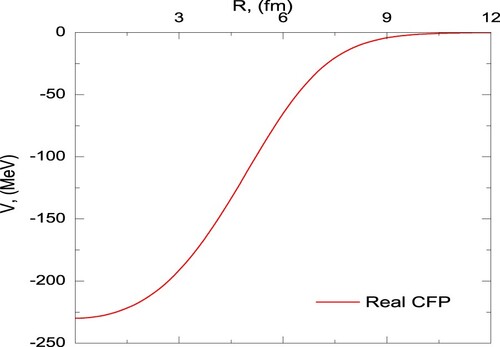
Table 1. Parameters of the d + 90Zr and α + 90Zr potentials used as inputs to the 6Li + 90Zr CF potential. Radii RW,D,SO = rW,D,SO x 901/3 fm.
3. Results and discussions
3.1. Analysis of 6Li+90Zr system using OM
Initially, the experimental ADs for 6Li, which are elastically scattered from 90Zr at energies of 14.89, 16.9, 18.9, 20.91, 24.92 and 29.93 MeV [Citation10], 34 MeV [Citation11], 60 MeV [Citation12], 70 MeV [Citation13], 73.7 MeV [Citation14], 99 MeV [Citation15], 156 MeV [Citation16], 210 MeV [Citation17] and 240 MeV [Citation18] are reanalyzed within the framework of OM using the potential presented in Equation (1). The performed OM analysis employed real and imaginary volume terms for each WS shape. The radii parameters for both real and imaginary parts are fixed to rV = 1.182 fm and rW = 1.627 as those in Ref. [Citation17], with four free changing parameters – potential depth and diffuseness for the two parts – till the best agreement between data and calculations is reached through minimizing the value χ2. The theoretical calculations performed in the current study using the different considered potentials were done utilizing FRESCO code [Citation34] and upgraded with χ2 minimization SFRESCO search code for searching the optimal potential parameters. As shown in Figures , the adopted OM is successfully reproduced the experimental data in the whole angular range using the optimal extracted parameters listed in Table . Table also presents the reaction cross-section (σR), real (JV) and imaginary (JW) volume integrals at all energies.
Figure 5. Comparison between 90Zr(6Li,6Li) 90Zr elastic scattering ADs (black solid circles) at Elab = 14.89, 16.9, 18.9, 20.81 and 24.92 MeV and OM calculations (red solid curves). The data are displaced by 0.5 for the sake of clarity.

3.2 Analysis of 6Li+90Zr system using SPP
In order to eliminate the parameter ambiguities which could be associated with OM calculations, analysis using more microscopic approaches is highly recommended. In the following approach, the analysis adopted a real folded potential based on the SPP with density distributions obtained from the Dirac-Hartree-Bogoliubov model [Citation29] as expressed in Equation (2), in addition to a WS imaginary potential of fixed rW = 1.627 fm as in the previously performed OM calculation. Using this approach, namely, (SPP Real + WS Imag.), the considered data are fitted using three parameters – NRSPP, W0, and aw (renormalization factor for real SPP, depth, and diffuseness for the imaginary WS potential). The implemented potential has the following form:
(8)
(8)
It is worth to mentioning that, although W0, and aw were free parameters, their extracted values using this approach were close to their values extracted from OM calculations. As shown in Figures , the adopted (SPP Real + WS Imag.) is successful in fitting the data in the whole angular range using the optimal extracted parameters listed in Table , and the quality of fitting is as good as for OM calculations. It is found that the real folded SPP strength should be reduced by ∼ 42% in order to obtain a good description of the data. The average extracted NRSPP is 0.58 ± 0.13. The main cause of such an observed reduction in NRSPP value is the significant coupling to break-up channel. The potential behaviour shows the characteristics of the BTA as it exhibits a reduction in the real part strength near the EC.B..
Figure 8. Comparison between 90Zr(6Li,6Li) 90Zr elastic scattering ADs (black solid circles) at Elab = 14.89, 16.9, 18.9, 20.81 and 24.92 MeV and SPP calculations (blue solid curves). The data are displaced by 0.5 for the sake of clarity.
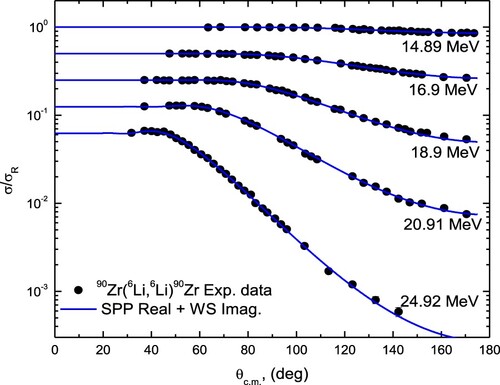
3.3. Analysis of 6Li+90Zr system using CFP
As reported in the previously performed calculations using (SPP Real + WS Imag.) approach, the real folded SPP strength should be reduced by ∼ 42% in order to obtain a good description of the data. So, it is necessary to reanalysis the considered data using another microscopic approach which takes into consideration the appreciable a + d cluster structure for 6Li to check if such a characteristic is still present. In the following approach, the analysis adopted a real microscopic potential based on the CFOM as expressed in Equation (3), while an imaginary WS potential of fixed rW = 1.627 fm as in the previously performed OM calculation, was included to simulate the absorption. Using this approach, namely, (CFP Real + WS Imag.), the considered data is fitted using three parameters: NRCF (renormalization factor for real CFP), W0, and aw. The implemented potential has the following form:
(9)
(9)
As shown in Figures , the adopted (CFP Real + WS Imag.) approach is successful in fitting the data in the whole angular range using the optimal extracted parameters listed in Table with nearly the same quality of fitting except at energies 210 and 240 MeV which underestimate the data especially at θc.m. > 30°. It is found that the real CFP strength should be reduced by ∼ 45% in order to obtain a good description of the data. The average extracted NRCF is 0.55 ± 0.14. The main cause of such an observed reduction in NRCF value is the break-up effects. The BTA phenomenon is also presented in the calculation using the (CFP Real + WS Imag.) approach and consequently does not obey the usual dispersion relation.
Figure 11. Comparison between 90Zr(6Li,6Li) 90Zr elastic scattering ADs (black solid circles) at Elab = 14.89, 16.9, 18.9, 20.81 and 24.92 MeV and CFP calculations (black solid curves). The data are displaced by 0.5 for the sake of clarity.
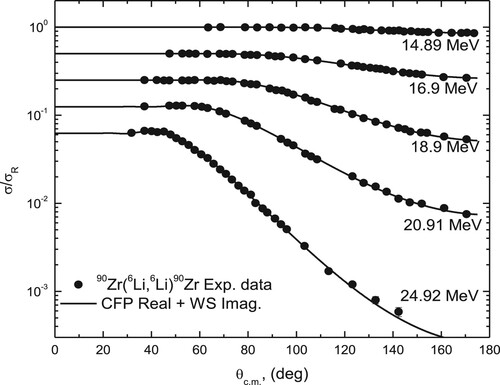
3.4. Analysis of 6Li+90Zr system using CFP with the inclusion of dynamic polarization potential
The observed reduction in real DF and CF potential strength as shown in the calculations performed using both (SSP Real + WS Imag.) and (CFP Real + WS Imag.) approaches is basically due to the significant coupling effect to the break-up channel. This effect is possible to be compensated using two techniques. The first technique is to perform the full microscopic CDCC method where the continuum is discretized into momentum bins of a certain width, and consequently, coupling to the continuum states of certain angular momentum is involved. The CDCC method is powerful, as the data can be fitted nearly without any renormalization, as was adopted in the work of Sakuragi et al. [Citation1–3]. The second technique which is used in the present work is the inclusion of a DPP of real repulsive surface potential. As shown in the aforementioned section, the 6Li+90Zr ADs were reproduced fairly using the (CFP Real + WS Imag.) approach, if the real CF potential strength is reduced by ∼ 45%. Now, and with adopting the DPP technique, the data are fitted using non-renormalized real CF potential “NRCF is fixed to unity” and using the same imaginary potential parameters extracted from (CFP Real + WS Imag.) approach in addition to a real repulsive surface DPP potential taken as a factor times the derivative of the previously created real cluster folding potential. In other words, the data was fitted using one free parameter (NDPP), which is the renormalization factor for the repulsive surface DPP. As shown in Figures , the agreement between the experimental 6Li+90Zr ADs and the theoretical calculations using the (non-renormalized CFP Real + WS Imag. + DPP) approach is fairly good using the potential parameters listed in Table .
Figure 14. Comparison between 90Zr(6Li,6Li) 90Zr elastic scattering ADs (black solid circles) at Elab = 14.89, 16.9, 18.9, 20.81 and 24.92 MeV and CFP calculations in addition to DPP (green solid curves). The data are displaced by 0.5 for the sake of clarity.
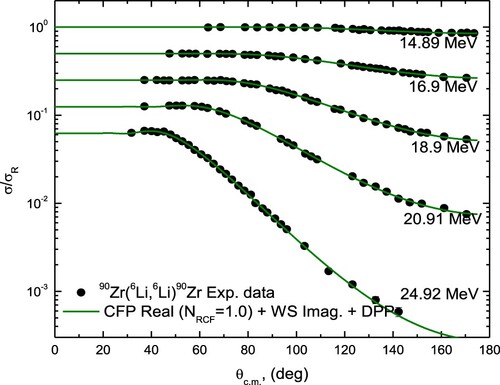
Figure 15. Same as Figure but at Elab = 29.93, 34, 60, 70 and 73.7 MeV. The data are displaced by 0.1 for the sake of clarity.
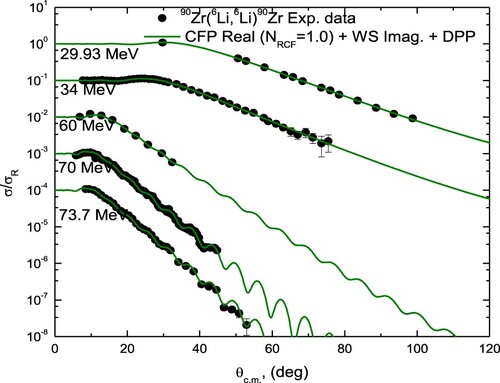
Figure 16. Same as Figure but at Elab = 99, 156, 210 and 240 MeV. The data are displaced by 0.01 for the sake of clarity.

In order to observe the presence or absence of the usual TA in 6Li+90Zr system, the energy dependence on both real and imaginary volume integrals extracted from the different considered approaches is plotted as shown in Figure . The plotted data emphasizes the absence of the usual TA, and that the BTA is well presented. This dependence doesn’t obey the usual dispersion relation. The energy dependence on σR values extracted from the different adopted approaches is plotted as shown in Figure . The extracted σR values are found to be in a good agreement with the values reported in Refs. [Citation10, Citation14, Citation15, Citation18]. The σR value increases with increasing energy and can be expressed by the following polynomial function as shown in Figure .
4. Summary
The weakly bound stable nucleus 6Li, exhibit a predominant α+d cluster structure at threshold energy 1.47 MeV, and hence it could be a useful tool to understand the break-up nature of the weakly bound unstable radioactive beams. In connection with this importance, experimental 6Li+90Zr elastic scattering ADs at fourteen energy sets ranging from 14.89 MeV and up to 240 MeV are investigated using different potentials constructed based on phenomenological, semi microscopic, and microscopic models. Firstly, OM calculations using real and an imaginary volume terms each has a WS shape of fixed radius parameter (rV = 1.182 fm and rW = 1.627 fm), were successful in reproducing the concerned data.
Then, the semi microscopic calculation based on a real potential part constructed using the SPP was performed in order to eliminate the ambiguities inherited in the phenomenological OM approach. The real part of the potential was derived using SPP and an imaginary volume part has a WS shape with fixed rW = 1.627 fm, the approach namely (SPP Real + WS Imag.). Calculations using the aforementioned approach showed the necessity to reduce the strength of the real DF potential by ∼ 42% in order to reproduce the experimental data.
Finally, the considered data is analyzed using a real part derived based on CFM due to the well-known d + α cluster structure for 6Li. Reasonable fitting could be obtained if the strength of the real CF potential is reduced by ∼ 45%. The observed reduction in the real CF and DF potential strength is mainly due to the 6Li break-up effect. The CFM + DPP calculation is performed with a non-renormalized real CF potential (NRCF = 1.0) in addition to a repulsive real surface potential which takes into account the coupling to the d + α break-up channel. From the current and our previous studies [Citation4–8], the break-up effect is strongly presented in systems involving weakly projectiles and it is independent of the considered target and the projectile’s energy. By comparing the extracted χ2 values listed in Tables , the performed analysis for 6Li+90Zr system using the different adopted potentials nearly give equally good fitting except at Elab = 210 and 240 MeV. The calculations using OM and (SPP Real + WS Imag.) approaches are in a better agreement with experimental data at Elab = 210 and 240 MeV in comparison with those using (CFP Real + WS Imag.) approach. The main reason of such observed deviation is probably due to the d + 90Zr and α + 90Zr potentials at energies Elab = 56 and 141.7 MeV, respectively, which are the most appropriate energies found in the literature for preparing the CFP for 6Li + 90Zr system. While, the actually required d + 90Zr and α + 90Zr potentials to fairly create the CFP for 6Li + 90Zr system at Elab = 240 MeV are those at: 80 MeV for d + 90Zr channel and 160 MeV for α + 90Zr channel.
Table 2. Extracted OM potential parameters for the 6Li+90Zr nuclear system with fixed rV = 1.182 fm and rW = 1.627 fm.
Table 3. Optimal potential parameters extracted from (SPP + WS Imag.) approach for the 6Li+90Zr nuclear system.
Table 4. Optimal parameters extracted from the 6Li+90Zr analysis using (CFP Real + WS Imag.) approach.
Table 5. Optimal potential parameters for 6Li+90Zr extracted from (CFP Real + WS Imag. + DPP) calculations using non-renormalized real cluster folding potential (NRCF = 1), an imaginary WS potential of the same parameters extracted from (CFP Real + WS Imag.) approach in addition to DPP of repulsive surface shape taken as a factor times real CFP.
Disclosure statement
No potential conflict of interest was reported by the author(s).
Additional information
Funding
References
- Sakuragi Y, Yahiro M, Kamimura M. Microscopic Coupled-Channels Study of Scattering and Breakup of Light Heavy-Ions . Prog Theor Phys Suppl 1986;89:136.
- Sakuragi Y. Energy and target dependence of projectile breakup effect in elastic scattering of 6Li. Phys Rev 1987;C35:2161.
- Sakuragi Y, Ito M, Hirabayashi Y, et al. Breakup Effect on the 6Li Elastic Scattering from 28Si at E/A = 35 and 53 MeV. Prog Theor Phys 1997;98:521.
- Hamada S, Ibraheem Awad A. Peculiarities of 6Li +12C elastic scattering. Int. J. Mod. Phys. E. 2019;E28:1950108.
- Hamada S, Alshahrani B, Elgamala A E, et al. Analysis of 6Li+16O elastic scattering using different potentials. Rev Mex Fis. 2020;66(3):322.
- Hamada S, Ibraheem Awad A. Cluster folding optical potential analysis for 6Li+28Si elastic scattering. Rev Mex Fis. 2021;67(2):276.
- Hamada S, Alsaif NAM, Ibraheem Awad A. Further investigation of B-10, B-11+ Ni-58 elastic scattering. Phys Scr 2021;96:055306.
- Ibraheem AA, et al. Elastic and Inelastic Scattering of 9, 10, 11Be by 64Zn and 120Sn Nuclei at Different Energies. Braz J Phys 2021;51:753.
- Hussein MS, Gomes PRS, Lubian J, et al. New manifestation of the dispersion relation: Breakup threshold anomaly. Phys. Rev. C. 2006;73:044610.
- Kumawat H, et al. Breakup threshold anomaly in the elastic scattering for the 6 Li + 90 Zr system. Phys. Rev. C. 2008;78:044617.
- Puigh RJ, Kemper KW. Scattering and transfer reactions for 6, 7 Li + 90, 91 Zr . Nucl Phys A. 1979;313:363.
- Wadsworth R, et al. A study of the ( 6 Li, 7 Be) reaction in the mass-90 region at 60 MeV . J. Phys. G; Nucl. Phys. 1983;9:1237.
- Horen DJ, et al. Systematics of isospin character of transitions to the 21 + and 3 − 1 states in 9 0 , 9 2 , 9 4 , 9 6 Zr. Phys. Rev. C. 1993;47:629.
- Huffman R, Galonsky A, Markham R, et al. Elastic scattering of 6 Li at 73.7 MeV. Phys. Rev. C. 1980;22:1522.
- Schwandt P, Jacobs WW, Kaitchuck MD, et al. Optical potential for 6 Li elastic scattering at 99 MeV. Phys. Rev. C. 1981;24:1522.
- Cook J, Gils HJ, Rebel H, et al. Optical model studies of 6Li elastic scattering at 156 MeV . Nucl Phys A. 1982;388:173.
- Nadasen A, et al. Unique 6Li nucleus optical potentials from elastic scattering of 210 MeV 6 Li ions by 28Si , 40Ca , 90Zr , and 208 Pb. Phys. Rev. C. 1989;39:536.
- Krishichayan X, Chen Y-W, Lui Y, et al. Elastic and inelastic scattering to low-lying states of 58 Ni and 90 Zr using 240-MeV 6 Li. Phys. Rev. C. 2010;81:014603.
- Schwarz K, et al. Reaction mechanism of 6Li scattering at 600 MeV . Eur Phys J A. 2000;7:367.
- Anwar M. Semimicroscopic analysis of 6 Li elastic scattering at 40 MeV/nucleon. Phys. Rev. C. 2020;101:064617.
- Xu Y, et al. 6 Li global phenomenological optical model potential. Phys. Rev. C. 2018;98:024619.
- Dan-Yang P. Effects of relativistic kinematics in heavy ion elastic scattering . Chin. Phys. C. 2014;38:024104.
- Hu L, Song Y, Hou Y, et al. The breakup coupling effects on the rainbow scattering of 6Li at 35 A MeV. Nucl Phys A. 2019;989:59.
- Xu YP, Pang DY. Toward a systematic nucleus-nucleus potential for peripheral collisions. Phys. Rev. C. 2013;87:044605.
- Chamon LC, et al. Toward a global description of the nucleus-nucleus interaction . Phys. Rev. C. 2002;66:014610.
- Chamon LC, Pereira D, Hussein MS. Parameterfree account of quasielastic scattering of stable and radioactive nuclei. Phys Rev 1998;C58:576.
- Chamon LC. The São Paulo Potential . Nucl. Phys. 2007;787(A):198c.
- Chamon LC, Carlson BV, Gasques LR. São Paulo potential version 2 (SPP2) and Brazilian nuclear potential (BNP). Comp. Phys. Comm. 2021;267:108061.
- Carlson BV, Hirata D. Dirac-Hartree-Bogoliubov approximation for finite nuclei. Phys Rev 2000;C62:054310.
- Nishioka H, et al. Projectile excitation and structure effects in 6Li and 7Li scattering. Nucl Phys A. 1984;415:230.
- Matsuoka N, et al. Optical model and folding model potentials for elastic scattering of 56 MeV polarized deuterons. Nucl Phys A. 1986;455:413.
- Goldberg DA, Smith SM, Burdzik GF. Refractive behavior in intermediate-energy alpha scattering . Phys. Rev. C. 1974;10:1362.
- Khoa DT. α -nucleus optical potential in the double-folding model. Phys Rev 2001;C 63:034007.
- Thompson IJ. Coupled reaction channels calculations in nuclear physics. Comput Phys Rep 1988;7:167.

